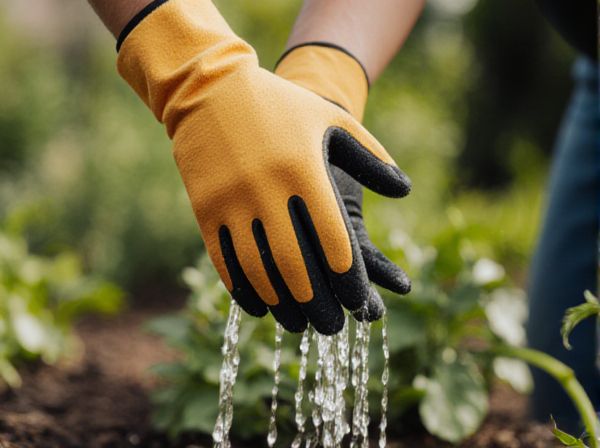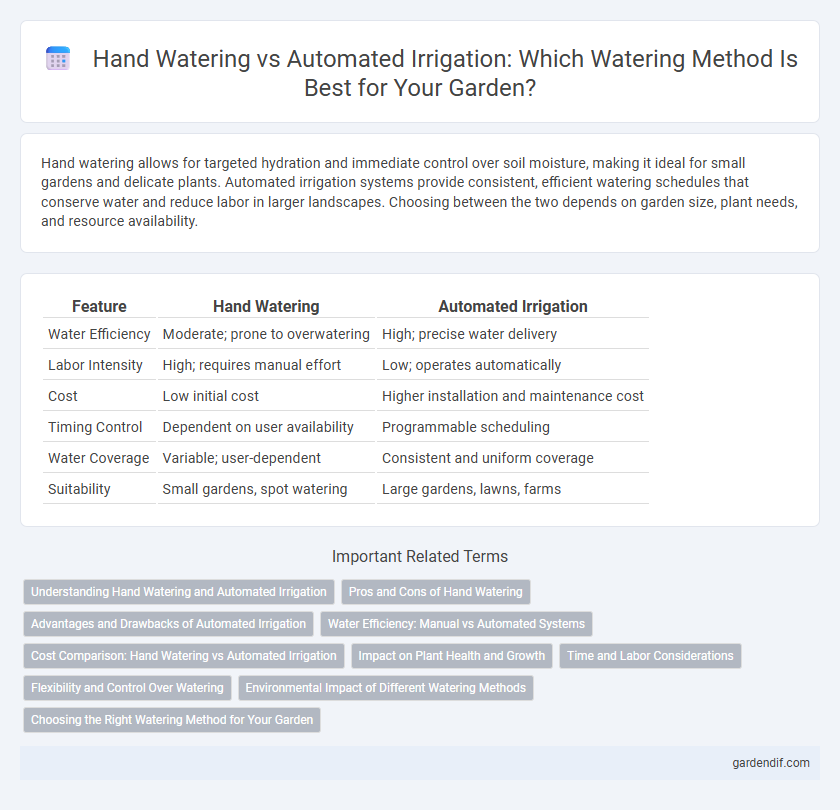
Hand watering vs Automated irrigation Illustration
Hand watering allows for targeted hydration and immediate control over soil moisture, making it ideal for small gardens and delicate plants. Automated irrigation systems provide consistent, efficient watering schedules that conserve water and reduce labor in larger landscapes. Choosing between the two depends on garden size, plant needs, and resource availability.
Table of Comparison
| Feature | Hand Watering | Automated Irrigation |
|---|---|---|
| Water Efficiency | Moderate; prone to overwatering | High; precise water delivery |
| Labor Intensity | High; requires manual effort | Low; operates automatically |
| Cost | Low initial cost | Higher installation and maintenance cost |
| Timing Control | Dependent on user availability | Programmable scheduling |
| Water Coverage | Variable; user-dependent | Consistent and uniform coverage |
| Suitability | Small gardens, spot watering | Large gardens, lawns, farms |
Understanding Hand Watering and Automated Irrigation
Hand watering provides precise control over water distribution, making it ideal for small gardens or delicate plants that require targeted moisture levels. Automated irrigation systems, such as drip or sprinkler setups, enable consistent and efficient water delivery across larger landscapes while conserving water by reducing runoff and evaporation. Choosing between hand watering and automated irrigation depends on garden size, plant types, water availability, and maintenance preferences.
Pros and Cons of Hand Watering
Hand watering offers precise control over the amount and placement of water, reducing waste and allowing targeted care for delicate plants. It requires minimal initial investment and enables gardeners to closely monitor soil moisture and plant health. However, it is time-consuming, labor-intensive, and less efficient for large gardens compared to automated irrigation systems that provide consistent moisture with less effort.
Advantages and Drawbacks of Automated Irrigation
Automated irrigation systems offer precise water distribution, conserving water by delivering the optimal amount at scheduled intervals, which enhances plant health and reduces labor costs. However, these systems can be expensive to install and maintain, and may malfunction due to technical issues or power outages, potentially leading to under- or over-watering. Despite the initial investment, automated irrigation is highly efficient for large-scale gardens or agricultural fields where consistent watering is crucial.
Water Efficiency: Manual vs Automated Systems
Hand watering often results in uneven water distribution and higher water waste due to human error and lack of precise control. Automated irrigation systems use sensor-based technologies and scheduled watering to optimize water usage, reducing runoff and evaporation significantly. Studies show automated systems can improve water efficiency by up to 30% compared to manual hand watering.
Cost Comparison: Hand Watering vs Automated Irrigation
Hand watering requires minimal initial investment, typically involving only a hose and watering can, making it cost-effective for small gardens. Automated irrigation systems demand higher upfront costs for equipment and installation but offer long-term savings through water efficiency and labor reduction. Over time, automated irrigation tends to lower overall expenses, especially in larger-scale or commercial horticultural settings.
Impact on Plant Health and Growth
Hand watering allows precise control of water application, reducing the risk of overwatering or underwatering and promoting healthier root development and plant growth. Automated irrigation systems ensure consistent moisture levels, which can enhance growth uniformity and reduce plant stress, especially in larger gardens or agricultural settings. However, improper settings in automated systems may lead to water waste or disease susceptibility, emphasizing the need for careful calibration to optimize plant health.
Time and Labor Considerations
Hand watering demands significant time and physical effort, especially for large gardens or landscapes, often requiring daily attention to ensure adequate moisture levels. Automated irrigation systems save labor by scheduling precise watering times, reducing the need for manual intervention and allowing consistent moisture delivery. Investing in automated systems can free up time while optimizing water efficiency through timed cycles and programmable settings.
Flexibility and Control Over Watering
Hand watering offers precise flexibility and control by allowing gardeners to target specific plants and adjust water amounts based on immediate needs, reducing waste and promoting plant health. Automated irrigation systems provide consistent, programmable watering schedules but may lack the adaptability to respond to varying weather conditions or plant requirements in real time. Combining both methods can optimize water efficiency, ensuring tailored hydration while maintaining overall system convenience.
Environmental Impact of Different Watering Methods
Hand watering conserves water by targeting plants directly, reducing runoff and evaporation compared to automated irrigation systems. Automated irrigation, while efficient in scheduling and coverage, can lead to overwatering and higher water consumption if not properly maintained. Choosing hand watering in drought-prone areas supports sustainable water use and minimizes environmental impact through precise water application.
Choosing the Right Watering Method for Your Garden
Hand watering offers precise control over water application, ideal for delicate plants or small garden areas where customization is essential. Automated irrigation systems provide consistent and efficient watering schedules, beneficial for larger gardens or when conserving water through timed, measured distribution. Selecting the optimal method depends on garden size, plant variety, water availability, and maintenance capacity to maximize growth and resource use.
Hand watering vs Automated irrigation Infographic

 gardendif.com
gardendif.com